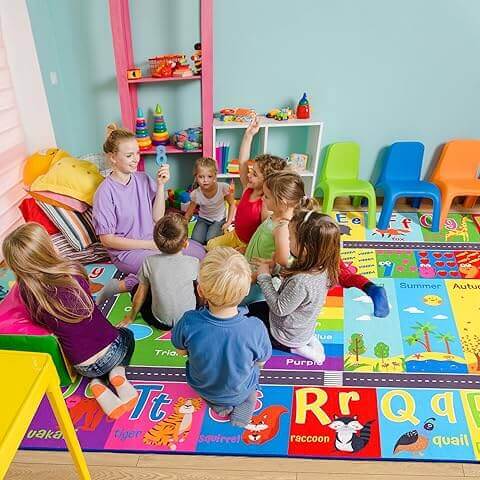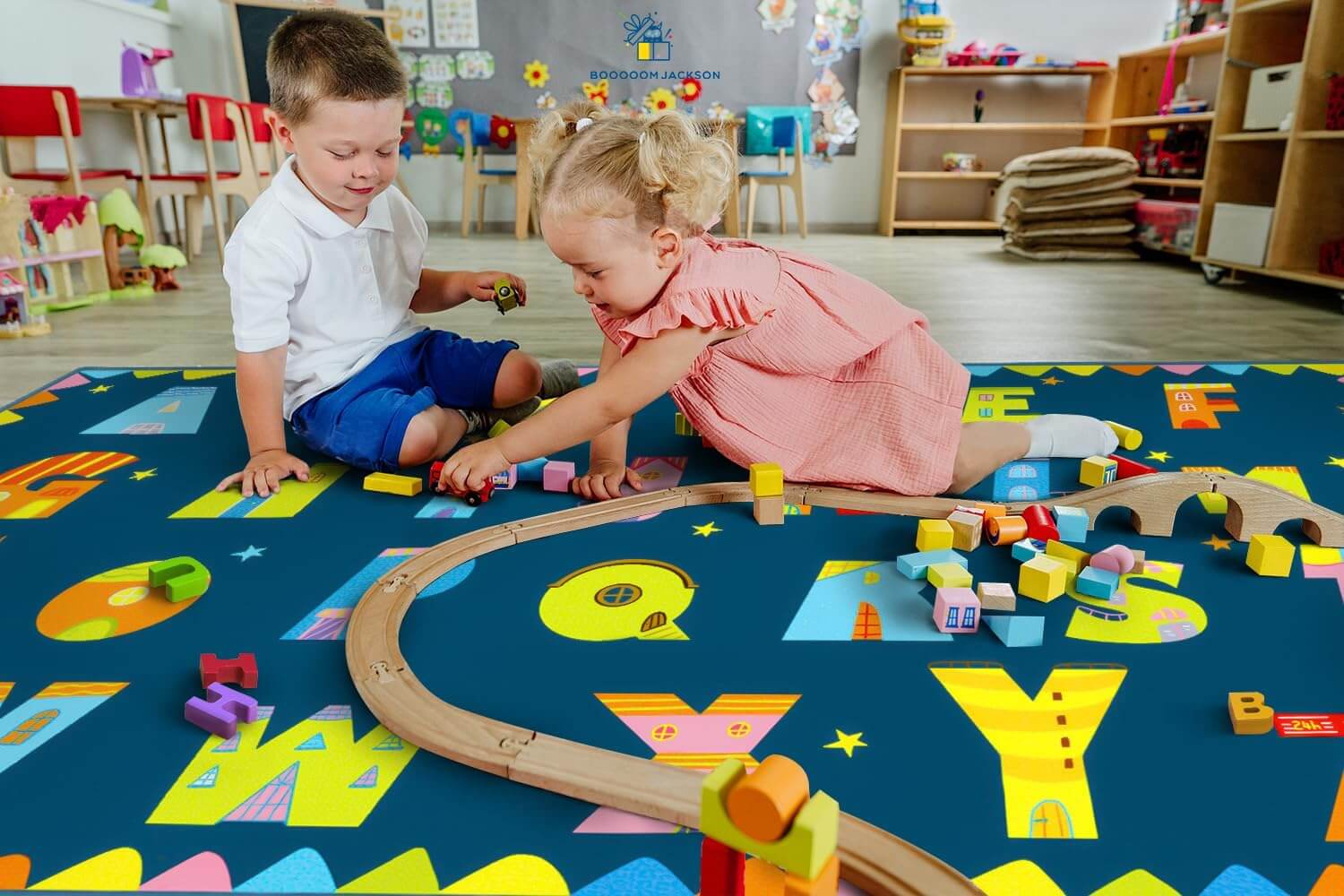Ever walked into a room and instantly felt calm, energized, or maybe even a bit cranky—without knowing exactly why? That's color psychology at work, folks! And when it comes to our littlest learners, those carpet colors beneath their wiggling toes might be doing a whole lot more than just hiding dirt between vacuuming days.
As teachers, we obsess over everything from bulletin board borders to perfect pencil organizers, but how much thought have you given to the color of your classroom rug?
At BooooomJackson, we've been diving deep into the fascinating world of color psychology to create carpets that don't just look pretty—they actually help shape young minds!
The Surprising Science Behind Classroom Colors
Turns out those color choices aren't just about aesthetics—they're affecting brain function! According to color psychology research, different hues can significantly impact mood, behavior, and even cognitive performance. And for developing brains? The effects are even more pronounced.
"I switched from my bright red reading corner carpet to a calm blue one last year, and the difference in my students' behavior was like night and day," shares Ms. Rodriguez from Sunnyside Elementary. "Suddenly my bouncy first graders could actually sit through an entire story without jumping up every three minutes!"
The Color Wheel of Learning: What Each Hue Does
BLUE: The Focus Facilitator
Blue might just be the MVP of classroom carpet colors! Studies from the University of British Columbia found that blue environments promote creativity, tranquility, and—perhaps most importantly for fidgety kiddos—improved attention spans.
Real-World Blue Magic: "My students with attention challenges gravitate toward our blue carpet corner during independent work time," notes special education teacher Mr. Washington. "Something about that color seems to help them settle their thoughts. I've actually started calling it our 'thinking spot'!"
GREEN: The Balance Builder
Green carpets bring the outdoors inside, creating that perfect balance between alertness and calm. According to environmental psychology experts, green spaces reduce stress hormones while maintaining healthy focus—basically the holy grail of classroom management!
Green Greatness in Action: Third-grade teacher Ms. Taylor observed, "Ever since we got our forest green carpet for our science center, my students spend nearly twice as long on their nature journals. The color seems to inspire their observations and keeps them engaged with the natural world we're studying."
YELLOW: The Energy Enhancer
Need to wake up those sleepy brains? Yellow is your go-to! This sunny hue stimulates mental activity, promotes optimism, and encourages communication. However, a word to the wise—childhood development specialists caution that a little yellow goes a long way. Too much can actually increase anxiety and frustration!
Yellow Zone Wisdom: "I use a small yellow carpet for our morning meeting area," explains kindergarten teacher Ms. Chen. "It's perfect for getting those morning brain juices flowing, but I deliberately chose a different color for our afternoon story time area when energy levels need taming, not boosting!"
RED: The Attention Grabber
Red carpets command attention and increase alertness—which can be both a blessing and a challenge in classroom settings! While red can be great for short-term energy boosts, educational environment experts warn that prolonged exposure may increase stress levels and even heart rates in young children.
Strategic Red Usage: "I keep a small red carpet square in my preschool classroom specifically for our quick transition songs," shares early childhood educator Mr. Patel. "The kids stand on it for our two-minute movement breaks between activities, and it seems to give them just the right energy jolt without overwhelming their systems."
PURPLE: The Imagination Igniter
Looking to spark creativity? Purple combines the calming aspects of blue with the energetic qualities of red, creating an ideal environment for imaginative play and creative expression. According to arts education researchers, purple environments can enhance artistic exploration and divergent thinking.
Purple Perfection: "Our purple storytelling rug has become central to our creative writing program," explains fourth-grade teacher Ms. Jackson. "Something about sitting on that rich purple seems to unlock my students' imaginations—their stories are noticeably more detailed and original compared to when we write at our desks."
Beyond Basic Colors: The Magic of Multicolor Designs
While understanding single-color psychology is valuable, most classroom carpets feature multiple hues. The key is thoughtful color combination and placement:
Learning Zone Color Coding
Strategic multicolor designs can actually help define different classroom areas and set behavioral expectations without a single word! According to classroom management specialists, color-coding learning zones creates visual cues that help students understand expectations in each area.
Color-Coding Success: "Our BooooomJackson Learning Landscape rug has four distinct color quadrants," explains second-grade teacher Mr. Thompson. "The blue zone is for quiet reading, green for science exploration, yellow for collaborative projects, and a small red section for our energizing brain breaks. My students instinctively adjust their behavior based on which color zone they're working in—it's like magic!"
The Pattern Factor
It's not just color choice but pattern complexity that affects young learners. Sensory processing experts suggest that:
- High-contrast patterns can overstimulate sensitive children
- Subtle tone variations support focus without distraction
- Gradual color transitions create calming visual experiences
Pattern Wisdom: "One of my students with sensory processing challenges would become visibly agitated on our old busy-patterned rug," shares inclusive education specialist Ms. Rodriguez. "We switched to a BooooomJackson Gentle Gradient design with subtle color shifts, and the difference in his ability to participate in circle time has been remarkable."
Practical Color Psychology: Putting Theory into Practice
Ready to harness the power of color in your classroom? Here are some practical applications:
Match Colors to Activities
Different learning activities benefit from different color environments:
- Reading and reflection: Blues and greens
- Brainstorming and collaboration: Yellows and oranges
- Creative expression: Purples and pinks
- Physical movement: Red accents (in small doses!)
Consider Your Specific Students
Every class has its own unique energy profile:
- High-energy classes often benefit from calming blues and greens
- Low-energy groups might need stimulating yellows and oranges
- Classes with diverse needs can benefit from zoned color areas
Account for Room Factors
Your carpet color doesn't exist in isolation:
- Natural light amplifies color effects (reduce intensity in bright rooms)
- Room size impacts color perception (lighter colors for smaller spaces)
- Existing wall colors should complement, not compete with, carpet hues
Real Classroom Color Transformations
Need some inspiration? Check out these teacher-reported color transformations:
"After years of struggling with hectic transitions, I divided our classroom with differently colored carpet squares," shares veteran teacher Ms. Washington. "The blue 'landing pad' by the door gives kids a calm entry point, then they move to their designated color zones based on their first activity. Our morning chaos disappeared almost overnight!"
"My special education classroom features our BooooomJackson Sensory Color Spectrum rug with graduated color intensities," explains Mr. Chen. "Students who need calming can work in the blue-green end, while those needing stimulation gravitate toward the yellow-orange section. It's like having built-in emotional regulation support right in our floor covering!"
Beyond the Rainbow: Color Temperature Considerations
Color psychology experts often talk about "warm" versus "cool" colors:
- Warm colors (reds, oranges, yellows) tend to energize and stimulate
- Cool colors (blues, greens, purples) typically calm and focus
According to environmental design researchers, temperature-balanced spaces provide the most versatile learning environments. In practical terms, this might mean a predominantly cool-colored carpet with strategic warm accents for balance.
The Cultural Color Context
It's important to note that color associations aren't universal. Cultural psychology studies show that color meanings vary significantly across different cultural backgrounds.
In diverse classrooms, selecting culturally neutral or balanced color schemes ensures all students benefit from your color psychology strategy. This multicultural awareness is particularly important in carpet designs featuring symbolic elements.
Making Your Color Psychology Carpet Choice
When selecting your next classroom carpet, consider:
- Your students' typical energy levels and temperaments
- The primary activities that will happen on the carpet
- Your existing classroom color scheme and lighting
- The size and placement of the carpet within your space
- The cultural backgrounds represented in your classroom
At BooooomJackson, we offer personalized color consultations to help you select the perfect carpet hues for your specific classroom needs. Because when it comes to learning environments, every color choice is actually a choice about learning outcomes!
The Bottom Line: Colors Matter More Than We Realize
While selecting classroom carpet colors might seem like a simple aesthetic decision, the science suggests it's much more significant. Those hues beneath little feet are quietly shaping mood, behavior, cognitive performance, and even creativity.
As early childhood expert Dr. Martinez puts it: "The colors surrounding young children aren't just decorative choices—they're neurological inputs during critical periods of brain development."
So the next time you're selecting a classroom carpet, remember—you're not just choosing a color; you're creating a neurological environment that will shape young minds every single day.




Leave a comment
This site is protected by hCaptcha and the hCaptcha Privacy Policy and Terms of Service apply.